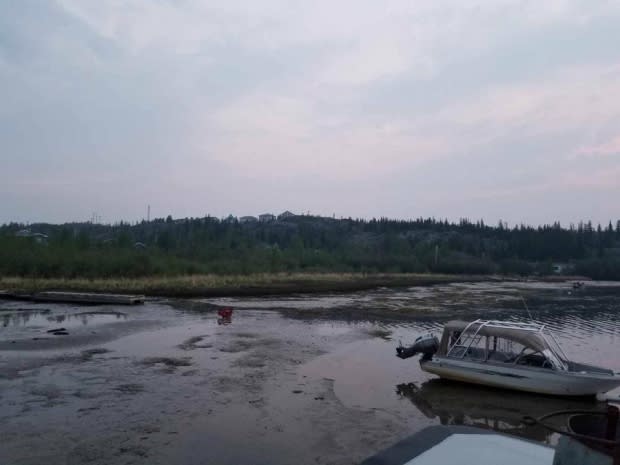Tides, glaciers or aliens: What caused Yellowknife's Back Bay to drain?
The phenomenon was as quick as it was dramatic.
Water levels dropped in Yellowknife's Back Bay dropped by approximately 25 centimetres in about the space of an hour, exposing large swaths of lake bed (and all the detritus littered on it) for about 30 minutes, before shooting back up.
Buffalo Airways' Mikey McBryan shared photos of the event on his official Facebook page Tuesday, garnering dozens of comments and more than 250 shares.
People raised theories that ranged from aliens, to lunar tides to meteorological events.
In the absence of reported UFO events in the Yellowknife area last night, the sudden drop in water levels did at least resemble something celestially caused.
Was it the moon?
While the National Ocean Service doesn't have tidal data on Great Slave Lake, it does have information about tides in similarly sized bodies of water.
"True tides … do occur in a semi-diurnal [twice daily] pattern on the Great Lakes," says a fact sheet from the organization.
"Studies indicate that the Great Lakes spring tide, the largest tides caused by the combined forces of the sun and moon, is less than five centimetres in height."

Other fluctuations in lake levels are big enough to mask this effect, which means the Great Lakes are considered to be non-tidal.
How about glaciers?
Andrew Kotaska, who has lived near Back Bay for 13 years, points to another phenomenon that affects water levels. The land around Yellowknife is rising.
During the last ice age, Yellowknife was buried below a giant glacier, and the effects of that glacier can still be seen on the land to this day in a process called isostatic rebound.
"It's, you know, a thousand or two thousand metres of ice," he said. "The weight is incredible — a quadrillion tons pushing down on the Earth's crust. Now that it's all melted, the Earth's crust is slowly rebounding back up."
The effect is measurable. According to research done by Natural Resources Canada, lake level recession in the Yellowknife area has marched on unabated at an average rate of five millimetres a year for the past 8,000 years.
It's a bit of a head-scratcher. - Terri Lang, meterologist, Environment Canada
Kotaska says isostatic rebound wouldn't cause the Earth's crust to suddenly spring up 25 centimetres in one night, but it does explain why, on average, Back Bay is getting shallower.
So if it wasn't glaciers, what was it?
Is the answer in the wind?
"It's a bit of a head scratcher," said Terri Lang, a meteorologist with Environment Canada.
Another popular theory is high winds could have blown the water out of Back Bay in a weather event called a seiche (pronounced "say-sh").
"It seems to me if it was caused by very, very strong winds, then those winds probably would have needed to come from the southwest," explained Lang. "And usually they have to be sustained winds as well for a long period of time."
Lang said the Yellowknife airport reported gusts of only 10 km/h at around midnight Monday evening. Any lightning strikes in the area — to indicate a storm was passing through — were to the north, and had ended hours before.

But this doesn't kill the seiche theory.
Hydrometric data from Yellowknife Bay show water levels rose and fell dramatically between 8 p.m. Monday evening and 4 a.m. Tuesday morning — the biggest oscillation being about 25 centimetres just before midnight.
This sloshing water effect was indeed caused by wind, according to Nathen Richea, director of water management and monitoring with the N.W.T. Department of Environment and Natural Resources.
"When winds are from a particular direction for a sustained period and wind direction aligns with a lake's orientation … increased water levels can occur," he stated in an email to CBC.
"Once the winds recede or reverse, water levels rebound or can drop for a short period of time until the water levels equalize on the lake."
The effect was dramatic in Back Bay simply because water levels have been extremely low this season anyway. Kotaska estimates they have ranged from six to 10 inches near the docks this season.


